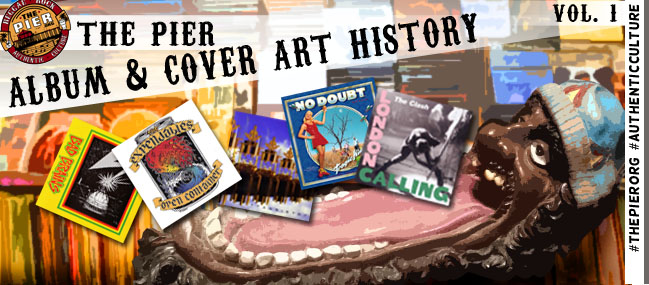
The Pier: Album & Cover Art History Vol. 1
Welcome to The Pier’s Album & Cover Art History – Volume 1. We say Volume 1 because this will be the first of 10 total volumes released over the next several months. Each volume will include 5 separate album covers discussing their concept & back-story.
In this feature, you’ll read how the album’s art has more depth to its meaning than just cool visuals thrown together. They’re cultural statements bringing the visual aesthetics to the music further branding the band. There are great stories to these covers & the albums. It pulls the curtain back with how the aligning art plays an integral part to the overall meaning of the album.
Enjoy the read below & let us know in the comments which Album & Cover Art you’d like us to explore in the future! If you find you’re not familiar with or don’t own any of these albums, then we encourage you to read this feature as a recommendation of what to add to your music collection!
Read all volumes to The Pier’s Album & Cover Art History:
311 – Transistor
Record Label: Capricorn Records
Release Date: August 5th, 1997
 After taking off in the early ’90’s as the new age Alternative-Rock band, 311 released Transistor in 1997, their longest album to date. Introducing new song structure and different genre-inspired guitar solos, riffs, and rhythms, as well as less rap inspired lyrics, Transistor became a standout entity in the long line of 311 albums. After the album was released, many critics blamed the band for using “fillers” to create an overly long track list. However, through the years many fans and critics alike have seemed to agree that this was an imperative album to the growth of 311, and since the album went Platinum, there’s no argument there.
After taking off in the early ’90’s as the new age Alternative-Rock band, 311 released Transistor in 1997, their longest album to date. Introducing new song structure and different genre-inspired guitar solos, riffs, and rhythms, as well as less rap inspired lyrics, Transistor became a standout entity in the long line of 311 albums. After the album was released, many critics blamed the band for using “fillers” to create an overly long track list. However, through the years many fans and critics alike have seemed to agree that this was an imperative album to the growth of 311, and since the album went Platinum, there’s no argument there.
Lead singer, Nick Hexum, had this to say about the album: “I think that the title and concept of ‘Transistor’ is that we’re all transistors of conducting the same energy. It’s like a scientific spiritual analogy about how we are all connected. I think that the cover art captured that, because it shows an ole timey transistor, but the dude is sitting in the lotus position inside the transistors. So it gives a more spiritual message there…”
Their lyrics have always had a defining message, and with Transistor, we see that the band took a new approach to their music during a time when the music-scene was littered with alternative and grunge rock. They became the “enlightened” band and took a powerful dive into a psychedelic reggae-rock inspired approach.
Written by: Andrew McClatchy
Watch: 311 – “Transistor”
No Doubt – Tragic Kingdom
Record Label: Trauma Records
Release Date: October 10th, 1995

No Doubt rocked the music charts with their third album, Tragic Kingdom and brought a huge wave of energy to ‘90s ska. The album cover, depicting an orange grove and a seductively posed Gwen Stefani, was the result of an awkward photo-shoot taken by Dan Arsenault.
The creation of Tragic Kingdom began in 1993, and almost did not come to light. Creator and keyboardist, Eric Stefani left the group in 1994, but they moved forward with the help of Eric’s little sister, Gwen, taking over the majority of song writing.
The title, “Tragic Kingdom”, came from a nickname guitarist Tom Dumont’s teacher had for Disneyland, or “The Magic Kingdom”, in the band’s hometown of Anaheim, California. The title also reflects the heartbreak Gwen felt after having the magic and fantasy surrounding her love with bass player Tony Kanal, destroyed. The contradictions between love and despair carry throughout the lyrics.
The album artwork places Gwen in the forefront, with the rest of the band in the background of an orange grove in their native Orange County. According to VH1, many of the band members reflected on a sense of jealousy, as Gwen stood out. To add additional vibes of discomfort, even though Eric had left the band, Gwen insisted for him to be included in the cover and can be seen near the back of the picture, looking away. The red dress worn by Gwen was loaned to the Orange County Hard Rock Café and was valued at $5,000 before it was stolen in 2005. Despite the tense photo shoot, the album was an absolute hit, although some reviewers credit the success to Gwen’s sex appeal.
Tragic Kingdom went double platinum by the following August ’96 and peaked at number one on weekly music charts across the world. The album was placed on Rolling Stone’s Top Rock Albums of All Time and gave way to a surge in record labels signing ska bands, pushing the genre to the mainstream.
Written by: Erin Walsh
Watch: No Doubt – “Just A Girl”
Bad Brains – Bad Brains
Record Label: ROIR (Reachout International Records)
Release Date: February 1982
 Bad Brains’ first full-length studio album was one of the fastest albums to ever be recorded when it was released. At the time it came out in February of 1982, it was a Cassette only release, something that isn’t heard of these days at all. It shocked listeners and influenced a musical revolution. The album was recorded by Jay Dublee at New York’s 171-A Studios and was originally released on cassette through Neil Cooper’s ROIR Records.
Bad Brains’ first full-length studio album was one of the fastest albums to ever be recorded when it was released. At the time it came out in February of 1982, it was a Cassette only release, something that isn’t heard of these days at all. It shocked listeners and influenced a musical revolution. The album was recorded by Jay Dublee at New York’s 171-A Studios and was originally released on cassette through Neil Cooper’s ROIR Records.
In 1979, the group’s reputation for rowdy fans made it difficult to book shows in Washington, D.C. After a confrontation with police, who were attempting to pull the plug on their show, Bad Brains wound up blacklisted with an unofficial ban among many D.C. area clubs and venues. The band subsequently relocated to New York City where they went on to develop another Hardcore Punk scene. They wrote a song, based on these events with, “Banned in D.C.” and preserved this history in their album art.
Created by Ratcage Reords’, Dave Lee Parsons, aka Mir, with a logo designed by Donnell Gibson and Jay Jones, the infamous cover-art focused on lightning striking the D.C. Capitol building. The concept suggested by ROIR label boss, the late Neil S. Cooper, depicted a statement against people in power. Described by Beastie Boys’ late Adam Yauch as “the best Punk/Hardcore album of all time,” Bad Brains was a crucial step in the formation of hardcore punk and the album was a big influence for the Reggae & Rock fusion, later made popular by bands like Sublime, Fishbone, 311, and Slightly Stoopid. The 1st release of the tape featured a white spine on the j-card in a solid red case.
Written by: Aaron Solomon
Watch: Bad Brains – “Banned in D.C.”
The Clash – London Calling
Release Date: December 14th, 1979
Record Label: CBS Records

The Clash released their third studio album, London Calling, on December 14, 1979. The cover features a photograph of bassist Paul Simonon about to smash his Fender Precision Bass on stage at The Palladium in New York City on September 21, 1979. This was during the Clash’s Take the Fifth US Tour.
After departing from their manager, Bernard Rhodes, The Clash embarked on a musical journey that departed from their punk rock sound. Two successful tours in the United States inspired the Clash to expand their musical horizons. At the behest of CBS Records, the band chose Guy Stevens to produce the album. His unconventional tactics included swinging a ladder around the studio and upturning chairs to create a rock and roll ambiance.
Pennie Smith, the photographer who captured The Clash for the album, originally did not want the Paul Simonon image used because she thought it was too out of focus. However, lead vocalist & guitarist Joe Strummer and graphic designer Ray Lowry said it would make a great cover for the record. The typography of “The Clash” and “London Calling” pays homage to Elvis Presley’s self-titled debut album that was released on March 23, 1956. Presley’s cover was ranked number 40 on Rolling Stone’s 100 greatest album covers. In 2002, London Calling was named the best album cover of all time by Q Magazine because it “captures the ultimate rock ‘n roll moment – total loss of control” (Judd, 2002).
The record itself received many accolades including the greatest album of all time by Thomas Erlewine of Allmusic, fourth greatest British album of all time by Q Magazine, sixth greatest album of the 1970s by NME, second best by Pitchfork Media. In 2003, Rolling Stone ranked it eighth on The 500 Greatest Albums of All Time. In 2007, London Calling was inducted into the Grammy Hall of Fame. Fans can view Paul Simonon’s iconic guitar on display at the Rock and Roll Hall of Fame in Cleveland, Ohio.
Written by: Blake Taylor
Watch: The Clash – “London Calling”
The Expendables – Open Container
Record Label: Independent release
Release Date: January 1st, 2002
 With the 2002 release of their 2nd album, Open Container, The Expendables were quickly making a name for themselves amongst the top reggae acts in California. The Santa Cruz natives are 4 long-time friends that formed the band in 1997 and are known for dueling guitar solos amongst a laid back reggae-rock feel.
With the 2002 release of their 2nd album, Open Container, The Expendables were quickly making a name for themselves amongst the top reggae acts in California. The Santa Cruz natives are 4 long-time friends that formed the band in 1997 and are known for dueling guitar solos amongst a laid back reggae-rock feel.
Shaun Logan, a childhood friend of bassist, Ryan DeMars, designed the cover art for Open Container. Most of the design was done while Shaun rode the Muni, going back and forth from school in San Francisco. His first task with the band was to design a shirt, which later became the cover for the No Time To Worry album. Since the period between “S.Logan” didn’t show up well, Shaun received the nickname, Slogan.
Slogan explains, “The concept came from the first design I did for the guys with the water and fire; reggae and rock symbolism for the guys style of writing. I wanted to bottle up the water and fire like it was on a shelf for purchase, like at a grocery store. The white background against the bright colors helped make the CD stand out at a merch table or record store.” Open Container was not named until Shaun presented the finished design to The Expendables.
Written by: David Garcia
Watch: The Expendables – “24/7” (Acoustic)
Read all volumes to The Pier’s Album & Cover Art History:

